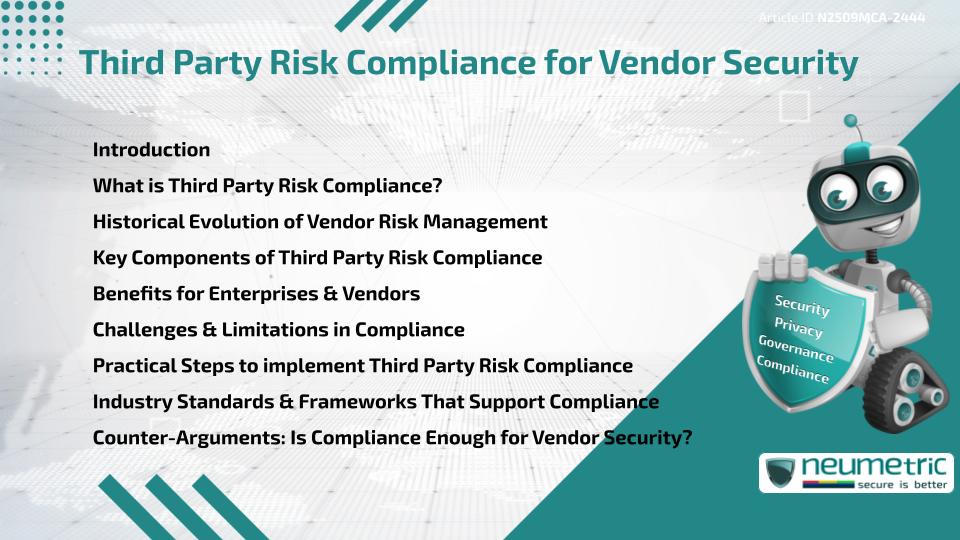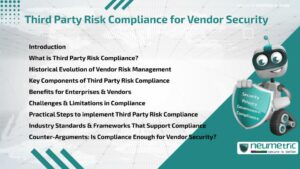Table of Contents
ToggleIntroduction
Third Party Risk Compliance plays a vital role in safeguarding enterprises that rely on Vendors, Suppliers & Service Providers. As organisations increasingly outsource functions such as IT services, Cloud hosting & Data processing, the Risks associated with external Partners have grown significantly. A Third Party Risk Compliance Framework helps enterprises identify, monitor & mitigate Risks to ensure Vendor security & Regulatory alignment. This article explores the meaning of Third Party Risk Compliance, its history, key elements, benefits, challenges, Industry Standards & whether Compliance alone is enough.
What is Third Party Risk Compliance?
Third Party Risk Compliance refers to the structured process of evaluating & monitoring Vendors to ensure they meet Security, Privacy & Regulatory requirements. It ensures that enterprises do not inherit Risks from their partners that could compromise Sensitive Data or disrupt Business Operations.
Think of it as an agreement where Vendors must follow the same protective measures as the enterprise itself. For example, if a Vendor handles Personal Data, Compliance ensures Encryption, Access Controls & Monitoring are in place. Without this, enterprises expose themselves to breaches caused by external lapses.
Historical Evolution of Vendor Risk Management
Vendor Risk Management traces back to the rise of outsourcing in the 1980s & 1990s, when enterprises began entrusting external partners with critical operations. Early frameworks like the Basel Accords emphasised Third Party oversight in Financial services.
With the advent of cloud computing & global supply chains, regulators began focusing more heavily on Vendor Compliance. Standards such as ISO 27001 & laws like the General Data Protection Regulation [GDPR] further formalised requirements for enterprises to manage Third Party Risks.
Key Components of Third Party Risk Compliance
A robust Compliance Framework should include:
- Due Diligence: Pre-contract Assessments of Vendor Security practices.
- Contractual Safeguards: Clearly defined clauses on Data Protection & Compliance obligations.
- Continuous Monitoring: Ongoing Reviews of Vendor performance & Security posture.
- Incident Response Integration: Aligning Vendor response plans with enterprise Procedures.
- Termination Processes: Ensuring secure offboarding of Vendors to prevent data exposure.
These elements create a cycle of oversight that extends throughout the Vendor relationship lifecycle.
Benefits for Enterprises & Vendors
Third Party Risk Compliance provides significant benefits:
- Reduced Exposure: Protects against Risks introduced by external partners.
- Regulatory Alignment: Ensures enterprises meet Compliance obligations across jurisdictions.
- Reputation Protection: Demonstrates due diligence to Customers & Stakeholders.
- Vendor Accountability: Encourages Vendors to uphold strong security practices.
When executed well, Compliance strengthens Trust between Enterprises & Vendors, creating a secure ecosystem.
Challenges & Limitations in Compliance
Despite its advantages, Third Party Risk Compliance presents challenges. Enterprises often deal with hundreds of Vendors, making consistent oversight complex. Smaller Vendors may lack resources to meet Compliance expectations, leading to friction in partnerships. Over-reliance on documentation instead of real performance monitoring can also create blind spots.
Practical Steps to implement Third Party Risk Compliance
Enterprises can establish effective Compliance programs by:
- Creating a centralised Vendor Inventory.
- Using Risk-based scoring to prioritise oversight.
- Implementing automated Monitoring Tools.
- Reviewing Vendor Compliance Reports regularly.
- Training procurement teams on Compliance Requirements.
By embedding these practices into procurement & operations, enterprises can sustain effective Vendor security.
Industry Standards & Frameworks That Support Compliance
Several frameworks guide enterprises in implementing Vendor Risk Compliance:
- ISO 27001 for security management.
- GDPR for Privacy & Data Protection in the EU.
- NIST Cybersecurity Framework for Risk Management.
- SOC 2 for Service Organisation Controls.
These standards provide enterprises with measurable criteria to evaluate & monitor Vendors effectively.
Counter-Arguments: Is Compliance Enough for Vendor Security?
Some experts caution that Compliance alone is not sufficient. Compliance frameworks often focus on minimum standards, while Threats evolve continuously. Enterprises must go beyond Compliance by fostering strong Vendor relationships, conducting regular Audits & adopting proactive Threat Intelligence. Thus, Third Party Risk Compliance should be seen as a foundation, not the endpoint.
Conclusion
Third Party Risk Compliance is indispensable for enterprises relying on external Vendors. It ensures Regulatory alignment, reduces Risks & fosters Trust in business relationships. Although it has limitations, its structured approach offers enterprises a powerful tool to manage Vendor security responsibly.
Takeaways
- Third Party Risk Compliance ensures Vendors meet Security & Regulatory requirements.
- It reduces Risks, protects Reputation & improves Accountability.
- Challenges include resource constraints & Vendor oversight complexity.
- It should be combined with proactive Risk Management, not used in isolation.
FAQ
What is the purpose of Third Party Risk Compliance?
Its purpose is to ensure Vendors meet security & regulatory requirements so enterprises do not inherit unnecessary Risks.
Who is responsible for Third Party Risk Compliance in an enterprise?
Responsibility typically lies with Risk Management, Compliance officers & procurement teams, though it requires cross-department collaboration.
How do enterprises monitor Vendors continuously?
They use tools such as automated monitoring platforms, Compliance Reports & regular assessments to maintain oversight.
Can small Vendors comply with the same standards as large enterprises?
Small Vendors may need tailored requirements, but they must still demonstrate basic Compliance with relevant Security & Privacy standards.
What happens if a Vendor fails Compliance checks?
Enterprises may require remediation, impose penalties or terminate contracts to protect their data & reputation.
How often should Vendor Compliance be reviewed?
At minimum, Vendor Compliance should be reviewed annually, with more frequent checks for high-Risk Vendors.
Need help for Security, Privacy, Governance & VAPT?
Neumetric provides organisations the necessary help to achieve their Cybersecurity, Compliance, Governance, Privacy, Certifications & Pentesting needs.
Organisations & Businesses, specifically those which provide SaaS & AI Solutions in the Fintech, BFSI & other regulated sectors, usually need a Cybersecurity Partner for meeting & maintaining the ongoing Security & Privacy needs & requirements of their Enterprise Clients & Privacy conscious Customers.
SOC 2, ISO 27001, ISO 42001, NIST, HIPAA, HECVAT, EU GDPR are some of the Frameworks that are served by Fusion – a SaaS, multimodular, multitenant, centralised, automated, Cybersecurity & Compliance Management system.
Neumetric also provides Expert Services for technical security which covers VAPT for Web Applications, APIs, iOS & Android Mobile Apps, Security Testing for AWS & other Cloud Environments & Cloud Infrastructure & other similar scopes.
Reach out to us by Email or filling out the Contact Form…





